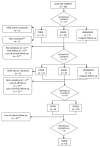Classic Ketogenic Diet and Modified Atkins Diet in SLC2A1 Positive and Negative Patients with Suspected GLUT1 Deficiency Syndrome: A Single Center Analysis of 18 Cases
- PMID: 33806661
- PMCID: PMC8000344
- DOI: 10.3390/nu13030840
Classic Ketogenic Diet and Modified Atkins Diet in SLC2A1 Positive and Negative Patients with Suspected GLUT1 Deficiency Syndrome: A Single Center Analysis of 18 Cases
Abstract
Background: Glucose transporter type 1 deficiency syndrome (GLUT1DS) is caused by mutations in the SLC2A1 gene and produces seizures, neurodevelopmental impairment, and movement disorders. Ketogenic dietary therapies (KDT) are the gold standard treatment. Similar symptoms may appear in SLC2A1 negative patients. The purpose is to evaluate the effectiveness of KDT in children with GLUT1DS suspected SLC2A1 (+) and (-), side effects (SE), and the impact on patients nutritional status.
Methods: An observational descriptive study was conducted to describe 18 children (January 2009-August 2020). SLC2A1 analysis, seizures, movement disorder, anti-epileptic drugs (AEDS), anthropometry, SE, and laboratory assessment were monitored baseline and at 3, 6, 12, and 24 months after the onset of KDT.
Results: 6/18 were SLC2A1(+) and 13/18 had seizures. In these groups, the age for debut of symptoms was higher. The mean time from debut to KDT onset was higher in SLC2A1(+). The modified Atkins diet (MAD) was used in 12 (5 SLC2A1(+)). Movement disorder improved (4/5), and a reduction in seizures >50% compared to baseline was achieved in more than half of the epileptic children throughout the follow-up. No differences in effectiveness were found according to the type of KDT. Early SE occurred in 33%. Long-term SE occurred in 10, 5, 7, and 5 children throughout the follow-up. The most frequent SE were constipation, hypercalciuria, and hyperlipidaemia. No differences in growth were found according to the SLC2A1 mutation or type of KDT.
Conclusions: CKD and MAD were effective for SLC2A1 positive and negative patients in our cohort. SE were frequent, but mild. Permanent monitoring should be made to identify SE and nutritional deficits.
Keywords: GLUT1 deficiency syndrome; SLC2A1 gene; ketogenic diet; movement disorder; pediatric epilepsy; refractory epilepsy.
Conflict of interest statement
Ruiz Herrero and González Gutiérrez-Solana have received honorarium for lectures and funding for travel from Nutricia. Cañedo Villarroya has received honorarium for lectures and funding for travel from Mead Johnson, Nestlé, Nutricia, Abbott, and Orphan. Puerta Macfarland has received honorarium for lectures from Nutricia. Pedrón Giner has served as consultant or received honorarium for lectures from Nutricia, Vitaflo, Nestlé, and Mead Jhonson; and has received funding for travel from Nutricia, Vitaflo, and Nestlé. García Alcolea and Gómez Fernández have no conflict of interest.
Figures



Similar articles
-
From splitting GLUT1 deficiency syndromes to overlapping phenotypes.Eur J Med Genet. 2015 Sep;58(9):443-54. doi: 10.1016/j.ejmg.2015.06.007. Epub 2015 Jul 17. Eur J Med Genet. 2015. PMID: 26193382
-
Favourable response to ketogenic dietary therapies: undiagnosed glucose 1 transporter deficiency syndrome is only one factor.Dev Med Child Neurol. 2015 Oct;57(10):969-76. doi: 10.1111/dmcn.12781. Epub 2015 Apr 23. Dev Med Child Neurol. 2015. PMID: 25914049
-
[Clinical characteristics and ketogenic diet therapy of glucose transporter type 1 deficiency syndrome in children: a multicenter clinical study].Zhonghua Er Ke Za Zhi. 2020 Nov 2;58(11):881-886. doi: 10.3760/cma.j.cn112140-20200822-00819. Zhonghua Er Ke Za Zhi. 2020. PMID: 33120458 Chinese.
-
Exploring ketogenic diet resistance in glucose transporter type 1 deficiency syndrome: A comprehensive review and critical appraisal.Epilepsia Open. 2025 Feb;10(1):31-39. doi: 10.1002/epi4.13110. Epub 2024 Dec 6. Epilepsia Open. 2025. PMID: 39641282 Free PMC article. Review.
-
GLUT1 Deficiency Syndrome-Early Treatment Maintains Cognitive Development? (Literature Review and Case Report).Genes (Basel). 2021 Aug 31;12(9):1379. doi: 10.3390/genes12091379. Genes (Basel). 2021. PMID: 34573360 Free PMC article. Review.
Cited by
-
One Molecule for Mental Nourishment and More: Glucose Transporter Type 1-Biology and Deficiency Syndrome.Biomedicines. 2022 May 26;10(6):1249. doi: 10.3390/biomedicines10061249. Biomedicines. 2022. PMID: 35740271 Free PMC article. Review.
-
Positive impact of a modified Atkins diet on cognition, seizure control, and abnormal movements in an adult with glucose transporter type 1 deficiency syndrome: case report.Neurol Sci. 2022 May;43(5):3449-3452. doi: 10.1007/s10072-022-05973-5. Epub 2022 Mar 3. Neurol Sci. 2022. PMID: 35243547 No abstract available.
-
Analysis of dietary fats intake and lipid profile in Chilean patients with glucose transport type 1 deficiency syndrome: similarities and differences with the reviewed literature.Front Nutr. 2024 May 16;11:1390799. doi: 10.3389/fnut.2024.1390799. eCollection 2024. Front Nutr. 2024. PMID: 38818131 Free PMC article.
-
The Ketogenic Diet in Obesity Management: Friend or Foe?Cell Biochem Biophys. 2025 Aug 29. doi: 10.1007/s12013-025-01878-0. Online ahead of print. Cell Biochem Biophys. 2025. PMID: 40879882 Review.
-
Solute Carrier Family 2 Member 1 Gene Mutation Presenting as Adult-Onset Paroxysmal Exercise-Induced Dyskinesia Without Epilepsy.J Clin Neurol. 2024 Nov;20(6):627-629. doi: 10.3988/jcn.2024.0349. J Clin Neurol. 2024. PMID: 39505316 Free PMC article. No abstract available.
References
-
- De Vivo D.C., Trifiletti R.R., Jacobson R.I., Ronen G.M., Behmand R.A., Harik S.I. Defective glucose transport across the blood-brain barrier as a cause of persistent hypoglycorrhachia, seizures, and developmental delay. N. Engl. J. Med. 1991;325:703–709. doi: 10.1056/NEJM199109053251006. - DOI - PubMed
-
- Leen W.G., Klepper J., Verbeek M.M., Leferink M., Hofste T., Van Engelen B.G., Wevers R.A., Arthur T., Bahi-Buisson N., Ballhausen D., et al. Glucose transporter-1 deficiency syndrome: The expanding clinical and genetic spectrum of a treatable disorder. Brain. 2010;133:655–670. doi: 10.1093/brain/awp336. - DOI - PubMed
Publication types
MeSH terms
Substances
Supplementary concepts
LinkOut - more resources
Full Text Sources
Other Literature Sources
Medical
Miscellaneous

